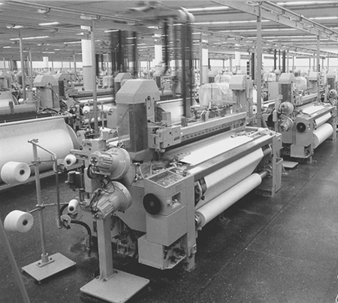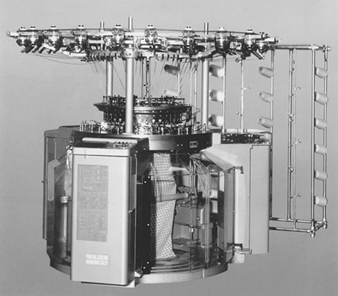Weaving and knitting are the two primary textile processes for manufacturing fabrics. In the modern textile industry, these processes take place on electrically powered automated machines, and the resulting fabrics find their way into a wide range of end-uses, including wearing apparel, home furnishings and industrial applications.
Weaving
The weaving process consists of interlacing straight yarns at right angles to one another. It is the oldest technology of manufacturing fabric: hand-powered looms were used in pre-Biblical times. The basic concept of interlacing the yarns is still followed today.
Warp yarns are supplied from a large reel, called a warp beam, mounted at the back of the weaving machine. Each warp yarn end is threaded through a heddles harness. The harness is used to lift or depress the warp yarns to allow the weaving to be done. The simplest weaving requires two harnesses, and more intricate woven fabrics require as many as six harnesses. Jacquard weaving equipment is used to manufacture the most decorative fabrics and has features to enable each individual warp yarn to be lifted or depressed. Each yarn end then is threaded through a reed of closely spaced thin parallel metal pieces mounted on the machine’s lay, or sley. The lay is designed to move in a reciprocating arc around a pivotal anchor point. The yarn ends are attached to the take-up roll. The woven fabric is wound on this roll.
The oldest technology for feeding the filling yarn across the width of the warp yarns is the shuttle, which is propelled in a free-flight fashion from one side of the warp yarn to the other side and pays out the filling yarn from a small bobbin mounted in it. New and faster technology, shown in figure 1, called shuttleless weaving, uses air jets, water jets, small projectiles that ride in a guidetrack, or small, sword-like devices called rapiers to carry the filling yarn.
Figure 1. Air-jet weaving machines
Tsudakoma Corp
Employees in weaving are typically grouped into one of four job functions:
- machine operators, commonly called weavers, who patrol their assigned production area to check on fabric production, correct some basic machine malfunctions such as yarn breaks and restart stopped machines
- machine technicians, sometimes called fixers, who adjust and repair the weaving machines
- direct production service workers, who transport and load raw materials (warp and filling yarn) onto the weaving machines and who unload and transport finished products (fabric rolls)
- indirect production service workers, who perform cleaning, machine lubrication and so on.
Safety risks
Weaving presents only a moderate worker safety risk. However, there are a number of typical safety hazards and minimization measures.
Falls
Objects on the floor that cause worker falls include machine parts and oil, grease and water spots. Good housekeeping is particularly important in weaving, since many of the process workers spend most of their workday patrolling the area with eyes directed to the production process rather than toward objects on the floor.
Machinery
Power transmission devices and most other pinch points are typically guarded. The machine lay, harnesses and other parts that must be frequently accessed by weavers, however, are only partially enclosed. Ample walking and working space must be provided around the machines, and good work procedures help workers avoid these exposures. In shuttle weaving, guards mounted on the lay are needed to prevent the shuttle from being thrown out, or to deflect it in a downward direction. Lockouts, mechanical blocks and so on are also required in order to prevent the introduction of hazardous energy into areas when technicians or others are performing job duties on stopped machines.
Materials handling
These can include lifting and moving heavy cloth rolls, warp beams and so on. Hand-trucks to help unload, or doff, and transport small cloth rolls from take-ups on the weaving machine reduce the risk of worker strain injuries by alleviating the need to lift the full weight of the roll. Powered industrial trucks can be used to doff and transport large cloth rolls from bulk take-ups placed at the front of the weaving machine. Wheeled trucks with powered or manual hydraulic assists can be used to handle warp beams, which usually weigh several hundred kg. Warp-handling workers should wear safety shoes.
Fires and ignition
Weaving creates a fair amount of lint, dust and fibre flyings which can represent fire hazards if the fibres are combustible. Controls include dust-collection systems (located under the machines in modern facilities), regular machine cleanings by service workers and use of electrical equipment designed to prevent sparking (e.g., Class III, Division 1, Hazardous Locations).
Health risks
Health risks in modern weaving are generally limited to noise-induced hearing loss and to pulmonary disorders associated with some types of fibres used in the yarn.
Noise
Most weaving machines, operating in the numbers found in a typical production facility, produce noise levels that generally exceed 90 dBA. In some shuttle and high-speed shuttleless weaving, levels may even exceed 100 dBA. Appropriate hearing protectors and a hearing conservation programme are nearly always necessary for weaving workers.
Fibre dust
Pulmonary disorders (byssinosis) have long been linked with dusts associated with the processing of raw cotton and flax fibres, and are discussed elsewhere in this chapter and this Encyclopaedia. Generally, ventilation and room air filtration cleaning systems with dust collection points under the weaving machines and at other points in the weaving area maintain dusts at or below required maximum levels (e.g., 750 mg/m3 of air in the OSHA cotton dust standard) in modern facilities. Additionally, dust respirators are needed for temporary protection during cleaning activities. A worker medical surveillance programme should be in place to identify workers who might be especially sensitive to the effects of these dusts.
Machine Knitting
There is a major cottage industry for the production of hand-knitted items. There are inadequate data on numbers of workers, generally women, thus engaged. The reader is referred to the chapter Entertainment and the arts for an overview of likely hazards. Editor.
The mechanical knitting process consists of interconnecting loops of yarn on powered automated machines (see figure 2). The machines are equipped with rows of small, hooked needles to draw formed yarn loops through previously formed loops. The hooked needles have a unique latch feature that closes the hook to easily allow the loop drawing and then opens to allow the yarn loop to slide off the needle.
Figure 2. Circular-knitting machine
Sulzer Morat
Circular-knitting machines have needles arranged in a circle, and the fabric produced on them comes off the machine in the shape of a large tube that is wound onto a take-up roll. Flat-knitting machines and warp-knitting machines, on the other hand, have needles arranged in a straight row, and fabric comes off the machine in a flat sheet for roll take-up. Circular- and flat-knitting machines are generally fed from yarn cones, and warp-knitting machines are generally fed from warp beams that are smaller but similar to those used in weaving.
Employees in knitting are grouped into job functions with duties similar to those in weaving. Job titles appropriately parallel the process name.
Safety risks
Safety risks in knitting are similar to those in weaving though generally of a lesser degree. Oil on the floor often is a little more prevalent in knitting due to the high lubrication needs of the knitting needles. Machine entrapment risks are less in knitting since there are fewer pinch points on the machines than those found in weaving, and much of the machinery lends itself well to enclosure guarding. Energy-control lockout procedures remain a must.
Cloth roll handling still presents a worker strain injury risk, but the heavy warp-beam handling risks are not present except in warp knitting. Risk control measures are similar to those in weaving. Knitting does not produce the levels of lint, flyings and dust that are found in weaving, but the oil from the process helps keep the fire fuel load at a level that needs attention. Controls are similar to those in weaving.
Health risks
Health risks in knitting are also generally lower than those in weaving. Noise levels range in the mid-80-dBA to low-90-dBA levels. Respiratory disorders for knitting workers processing raw cotton and flax do not appear to be especially prevalent, and regulatory standards for these materials are often not applicable in knitting.


